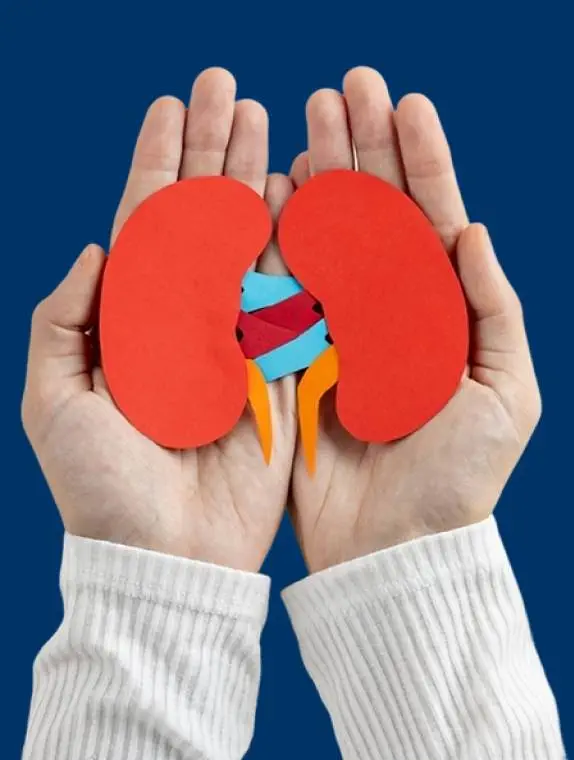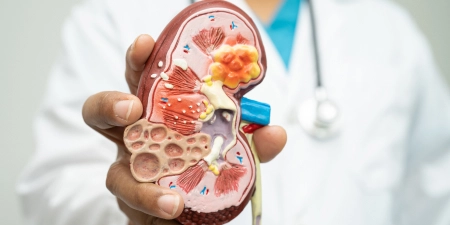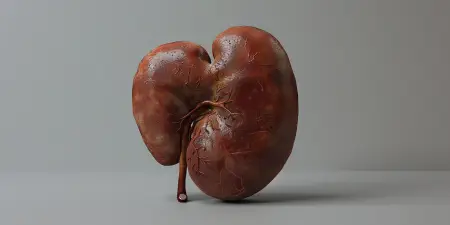Robotic Assisted Nephrectomy Procedure

Robotic Nephrectomy: Precision Kidney Surgery with Expert Care
When it comes to sophisticated urological surgeries, Dr. Aarthy stands out as a trusted expert for her experience in robotic-assisted nephrectomy procedures. She is a renowned robotic urologist in Chennai, known for her comprehensive, patient-centric approach and tailored surgical plans that deliver optimal patient outcomes.
Dr. Aarthy is a perfectionist in executing robotic nephrectomy, an advanced, minimally invasive kidney removal procedure using robotic-assisted technology. This innovative approach is often recommended for patients with kidney tumours or damaged or diseased kidneys.
A poorly functioning kidney can be a health setback. However, with Dr. Aarthy at the helm, you can rest assured that your health is in capable hands as you embark on your journey towards better renal function.
When is Robotic Nephrectomy Surgery Necessary?
Robotic-assisted surgeries may be the best option to extricate the kidneys for the following medical reasons:
Expert Care For Your Precious Kidneys

- Before Surgery
- What to Expect?
- Post-Surgical Care
Robotic Nephrectomy: Preparatory Guidelines
Undergo a thorough assessment of your renal and general health with the help of blood and urine tests, diagnostic scans, and a medical history review.
Inform your doctor of your current medication intake, including over-the-counter and supplemental medicines. If you take blood thinners, your doctor may ask you to temporarily discontinue them.
Avoid food and drink at least eight hours before your scheduled appointment to facilitate a safe and uncomplicated procedure.
Quit smoking and alcohol intake to ensure a risk-free surgery and a wholesome healing process.
Arrange for a family member or friend to drive you back home and support you in the initial stages of your recovery period.
Wear loose clothing after showering with the antiseptic wash provided by your hospital. Follow your doctor’s other pre-surgical instructions.
Robotic Nephrectomy Surgery: What to Expect?
A certified anaesthetist will commence the procedure by administering general anaesthesia and rendering you completely unconscious and pain-free.
Your uro surgeon will make several small incisions in your abdominal region to insert the robotic instruments and a high-definition camera to perform the nephrectomy.
The surgeon will control the robotic arms using the system’s console, guide the surgical instruments with steady movements, and perform the procedure with pinpoint accuracy.
Your surgeon will perform either a partial (a part of the kidney) or radical nephrectomy (the entire kidney ) while carefully preserving the surrounding renal tissues. The nephrectomy depends on the complexity of your case.
Once the damaged kidney tissue is removed, your surgeon will remove the surgical instruments and close the incision with sutures or surgical glue.
Once your sutures are properly covered and bandaged with sterile gauze, you will be moved to a recovery room and closely monitored to ensure your safety as you awaken from the anaesthesia.
Robotic Nephrectomy: Post-Surgical Care
Like every surgery, robotic surgery for kidney removal also requires uncompromised post-surgical care to ensure a quick and wholesome recovery.
Facilitate your recovery by taking the prescribed painkillers and antibiotics to prevent any complications.
Look for signs of infection, such as high fever, pain, swelling, and redness around the incision site. Consult your doctor without delay if you experience these symptoms.
Avoid lifting heavy objects and engaging in strenuous activity for at least 4-6 weeks after surgery. Start with small walks and gradually increase your physical activity to promote blood circulation and minimise the risk of clots.
Take a nutritious, balanced, high-fibre diet to nourish your body and aid your bowel movements.
Take extra care to keep your incision area dry and clean, and strictly adhere to your surgeon’s instructions regarding your first post-surgical shower and wound care guidelines.
Schedule regular appointments with your surgeon to monitor your healing progress and discuss any issues that may arise.
TURP Procedure: What to Expect?
Follow these guidelines to expedite your recovery from Transurethral Resection of the Prostate:
Expect one or two days of hospital stay after your TURP surgery. During this period, a catheter will be inserted to drain urine from your bladder as the surgical site heals.
Maintain adequate hydration by consuming enough fluid intake. It will facilitate bladder cleansing and aid your healing process.
Refrain from engaging in strenuous activities, heavy lifting, and intense exercise for at least 4-6 weeks post-procedure.
Be diligent with your follow-up appointments, and inform Dr Aarthy if you experience fever, pain, or bleeding at the surgical site.
Do bladder training exercises to restore your bladder control since it can take time for the bladder to acclimatise post-surgery.
Robotic Nephrectomy:
The Benefits

Minimally Invasive
Smaller incisions and a less invasive approach cause less tissue damage and minimal or nil complications.
Better Accuracy
Advanced robotic surgery, using a high-definition camera, provides a crystal-clear vision of the surgical site, allowing for precision excision of the damaged tissues.
Fewer Complications
Small incisions, minimal intrusion, and less tissue damage eliminate the risk of complications during and after surgery.
Quicker Recovery
With proper post-surgical care, the smaller incisions heal faster and facilitate your return to routine life.
Minimal Pain
Reduced post-operative pain due to the small incisions and minimum tissue damage after surgery.
Better Surgical Outcomes
Minimal scarring, quick healing, and improved renal health, thanks to precise and advanced robotic surgical techniques.
Invest in Your Kidney Care






